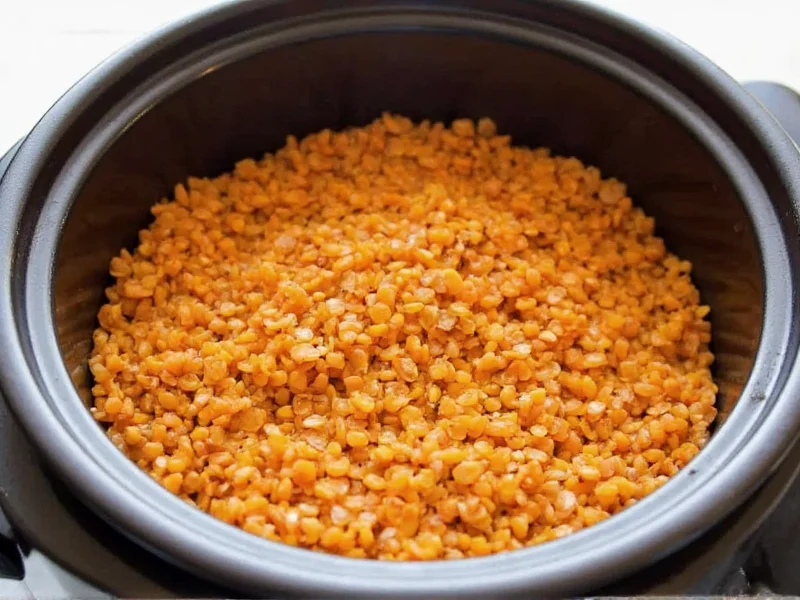Discover the effortless way to prepare perfect lentils every time using your rice cooker. This versatile kitchen appliance, typically reserved for grains, excels at cooking lentils with minimal supervision and consistent results. Unlike stovetop methods that require constant monitoring, the rice cooker's automatic settings prevent boiling over and ensure even cooking without constant attention.
Why Cook Lentils in a Rice Cooker?
The rice cooker's precise temperature control creates ideal conditions for lentil preparation. The gentle, consistent heat prevents the common pitfalls of stovetop cooking—burning on the bottom or uneven texture. This method requires less hands-on time while delivering restaurant-quality results. Busy home cooks appreciate how the rice cooker frees up stove space and automatically switches to 'keep warm' mode when done, preventing overcooking.
Lentil Varieties and Cooking Times
Not all lentils behave the same in a rice cooker. Understanding the differences ensures perfect texture every time:
| Lentil Type | Water Ratio | Cook Time | Texture Result |
|---|---|---|---|
| Red lentils | 1:1.5 | 15-20 minutes | Soft, creamy (ideal for soups) |
| Brown lentils | 1:2 | 25-30 minutes | Firm yet tender (salads, sides) |
| Green lentils | 1:2 | 25-30 minutes | Hold shape well (hearty dishes) |
| Black beluga | 1:2.25 | 30-35 minutes | Rich, earthy flavor (garnishes) |
Step-by-Step Rice Cooker Lentil Method
Follow these professional techniques for flawless lentils without fail:
- Rinse thoroughly - Place lentils in a fine-mesh strainer and rinse under cold water until water runs clear. This removes debris and reduces foaming.
- Measure precisely - Use the rice cooker's measuring cup for consistency. Different lentil varieties require specific water ratios as shown in the table above.
- Add flavor foundation - After adding water, include 1 bay leaf, 2 smashed garlic cloves, and 1 teaspoon cumin for enhanced flavor without complicating the process.
- Select appropriate setting - Use 'regular' or 'white rice' setting for most varieties. Avoid 'quick cook' settings which can cause uneven texture.
- Let it rest - After cooking completes, allow lentils to sit undisturbed for 10 minutes with the lid closed. This crucial step ensures even moisture distribution.
- Fluff and season - Gently fluff with a fork, then add salt and acid (lemon juice or vinegar) to taste. Adding salt before cooking can toughen lentils.
Pro Tips for Perfect Results
Professional chefs recommend these techniques for optimal rice cooker lentil preparation:
- No soaking required - Unlike beans, lentils don't need pre-soaking, making them ideal for quick meals
- Avoid lifting the lid - Steam escape during cooking extends time and creates uneven results
- Adjust water for altitude - At elevations above 3,000 feet, increase water by 1/4 cup per cup of lentils
- Use broth instead of water - For richer flavor in dishes like lentil soup in rice cooker or lentil curry preparation
- Add acidic ingredients late - Tomatoes or vinegar added too early can prevent proper softening
Troubleshooting Common Issues
Resolve these frequent lentil cooking challenges:
Mushy lentils: Usually caused by too much water or overcooking. Reduce water ratio by 1/4 cup next time and check for doneness 5 minutes early. Red lentils naturally become soft, making them perfect for lentil soup but less suitable for salads.
Undercooked lentils: If lentils remain hard after cooking cycle, add 2-3 tablespoons water and restart the cook cycle for 5-7 minutes. Older lentils often require slightly more water and time.
Boiling over: Rinse lentils thoroughly to remove excess starch, and never fill the rice cooker more than halfway when cooking lentils. For foolproof lentil and rice combinations, use the absorption method with precise measurements.
Delicious Variations to Try
Elevate your basic cooked lentils with these simple adaptations:
Mediterranean style: After cooking, toss with olive oil, lemon zest, chopped parsley, and crumbled feta. Perfect for meal prep lunches or as a side dish for grilled meats.
Curried lentils: Add 1 tablespoon curry powder and 1/2 cup coconut milk during the last 5 minutes of cooking. Ideal for quick weeknight dinners when served over rice.
Lentil soup base: Cook lentils with diced carrots, celery, and onion using vegetable broth. After cooking, blend partially for creamy texture while maintaining some whole lentils for substance.
Storage and Reheating Guidelines
Proper storage maintains texture and flavor for future meals:
- Cool cooked lentils within 2 hours of preparation
- Store in airtight containers with some cooking liquid to prevent drying
- Refrigerate for up to 5 days or freeze for 3 months
- Reheat gently with a splash of water to restore moisture
- Use leftover lentils in salads, soups, or as a protein-packed side dish
Mastering the art of cooking lentils in rice cooker opens possibilities for healthy, protein-rich meals with minimal effort. Whether you're preparing basic lentils for meal prep, creating hearty soups, or experimenting with international flavors, this method delivers consistent results. The beauty of this technique lies in its simplicity—set it and forget it cooking that produces perfect lentils every time, freeing you to focus on other meal components. For those exploring plant-based diets or seeking affordable protein sources, this rice cooker lentil method becomes an indispensable kitchen skill that transforms a humble ingredient into versatile culinary foundation.











 浙公网安备
33010002000092号
浙公网安备
33010002000092号 浙B2-20120091-4
浙B2-20120091-4